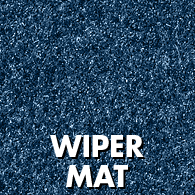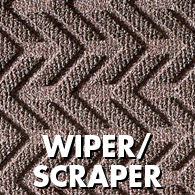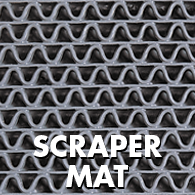
A Cleaning Q&A Column | February 7, 2013
Q: Hey Sadie- How do I know what kind of mat(s) I need for my facility? - Steven
A: Hello Steven, Having a matting program is the best way of adding mats to a facility. Not only are mats a great way to protect your floors, especially in inclement weather, but they can add traction for feet near pools (in gyms, schools, etc.), help prevent worker fatigue where people stand all day (such as in commercial kitchens, manufacturing facilities, etc.), and many other various applications.
Often it’s best to have different types of mats that are specific to the needs of the various areas in your building or facility. For instance, one would not use an anti-fatigue mat for an entryway, as you'd want it in an area that someone would be standing all day, as opposed to people wiping their feet of debris when entering a building. And that's why having a matting program is the optimal solution.
Understanding matting terms is important to figuring out what you need...wiper mats vs. scraper mats vs. wiper/scraper mats. CleanLink.com has published an article defining various mat-related terms that often need clarifying (read below for "Ten Terms Everyone Should Know About Mats").

Mats provide many benefits including:
- Longer life for carpets & hard floor surfaces
- Easy maintenance
- Saves you money (by protecting your carpets & hard floor surfaces)
- Provides traction for shoes in bad weather
- Improves indoor air quality by keeping out more dirt, grime and dust
- Prevents more slips & falls
- Defends against worker fatigue (especially foot, leg and back pain)
- Enhances the appearance of a facility, plus comes in a variety of colors & styles
If you’d like to implement a matting program in your facility, contact WAXIE (800) 995-4466 and we’ll help you create a customized program specific to your needs. We can also answer any of your matting questions.
Want to learn more about protecting your carpets? Download WAXIE’s Carpet Care Resource Guide.
Ten Terms Everyone Should Know About Mats
Republished with permission from CleanLink.com
There are a variety of matting options that are designed for and used in a plethora of facilities. These options can cause confusion and, according to JoAnne Boston, business development head at Crown Mats and Matting, the various types can be misunderstood by cleaning professionals.
“A good example of this is the term high-performance mat,” says Boston. “While it sounds like it refers to how well a mat performs, it actually refers to how long it lasts. A high-performance mat is designed to withstand very heavy foot traffic and last between three and five years.”



Other mat-related terms that often need clarification are:
- Wiper: Wiper mats are placed inside the doors of a facility to absorb any remaining moisture and soil on a walker’s shoes.
- Scraper: Scraper mats are placed outside a facility and are intended to aggressively scrape soil and debris from shoe bottoms.
- Wiper/Scraper: Wiper/scraper mats wipe and dry shoe bottoms and are placed following a scraper mat but before a wiper mat.
- Ergonomic: Ergonomic mats offer a combination of softness (give) and support (resilience) to help reduce worker fatigue.
- Anti-Fatigue: Anti-fatigue mats offer even greater comfort, bounce and support to help increase worker productivity and decrease pain, injuries, and soreness.
- Anti-static: Anti-static mats are designed to help reduce static electricity.
- Non-conductive: Non-conductive mats help insulate and protect workers from serious shocks that can be generated by high voltage.
- Specialty: Something of a catch-all, this terms refers to a variety of different matting products; for instance, a mat placed under a chair to protect the floor below, a gym mat, even a meditation mat.
- Bi-level: Bi-level mats store soil and water below shoe level for later removal. This prevents contaminants from being transferred onto floor surfaces.
“You’d be surprised how many people still think of mats as just being door mats,” adds Boston. “The entire matting industry has come a long way from just making door mats.”
Source: http://www.cleanlink.com/15187news/


